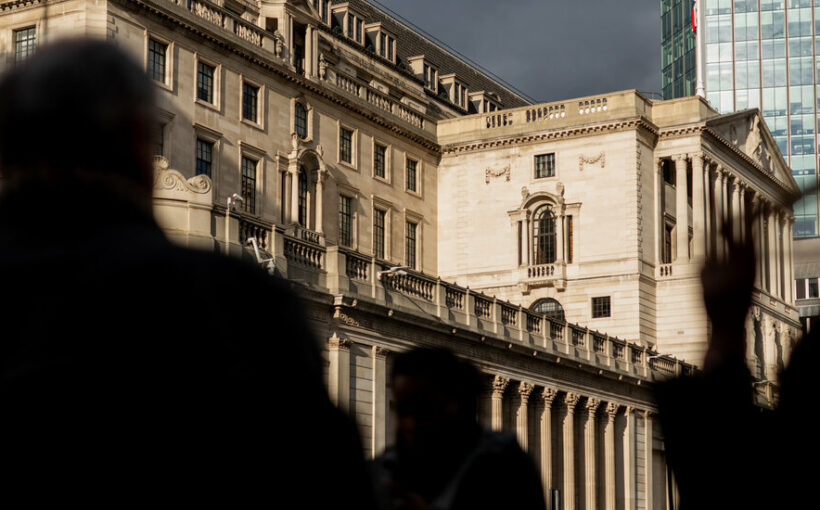The Bank of England raised interest rates on Thursday, its 12th consecutive increase, as Britain’s inflation rate remained stubbornly in the double digits.
Policymakers lifted the central bank’s key interest rate a quarter of a percentage point to 4.5 percent, the highest since 2008. The long and aggressive policy tightening has continued as Britain experiences inflation that is higher than in the United States and Western Europe. Consumer prices rose 10.1 percent in March from a year earlier, the latest data showed, as food prices have risen more rapidly than expected, alongside prices of other goods such as clothing.
The rate increase addresses “the risk of more persistent strength in domestic price and wage setting,” according to the minutes of the bank’s meeting this week.
Britain’s inflation rate is expected to fall more slowly than the central bank expected three months ago, primarily because food price inflation is forecast to decline slowly. In March, food prices were nearly 20 percent higher than a year earlier, the fastest pace of inflation in more than 45 years.
By the end of the year, the headline rate of inflation, which includes food and energy prices, is forecast to fall to 5.1 percent, the central bank forecast. Consumer price data for April, which will be published later this month is expected to show inflation beginning a more substantial slowdown because a surge in household energy bills will wash out of the annual inflation calculations. A year earlier, household energy bills surged more than 50 percent after the war in Ukraine pushed up wholesale prices.
As the Bank of England tries to force inflation down to its 2 percent target, good economic news could complicate its mission. Three months ago when the central bank last published its forecasts, it had a particularly pessimistic view of the British economy, predicting a five quarters of economic contraction and a mild recession. On Thursday, it unveiled the biggest upgrade to its economic forecasts in the bank’s history, because of lower wholesale energy prices and extra fiscal stimulus from the government. It no longer foresees any quarters of economic contraction.
Instead of a recession, this better-than-expected growth, with lower unemployment and rising consumer confidence, could allow some of the inflationary pressures in the economy to persist for longer than previously thought.
“Repeated surprises” about the resilience of economy and the tightness of the labor market have created “circumstances in which domestic price pressures risked becoming more persistent,” the policymakers who voted to raises interest rates said, according to the minutes of the meeting.
Still, the upgraded economic outlook is likely to offer only limited comfort to households and businesses. The forecast is weak: The economy would grow about a quarter of a percent this year, according to the bank’s projections.
The Bank of England was the first major central bank to start raising rates nearly a year and a half ago. Now investors and economists are trying to gauge how soon central banks, including the Federal Reserve and the European Central Bank, will pause their increases. In the United States, inflation fell below 5 percent last month and the Fed chair, Jerome H. Powell, opened the door to a pause in rates amid turmoil in the U.S. banking sector.
In the eurozone, inflation has also peaked, but so-called core inflation, which excludes food and energy prices, is still strong. Last week, Christine Lagarde, the president of the E.C.B., said the bank was not done raising rates yet, as it only started lifting rates last summer.
Policymakers at the Bank of England gave few clues about what will come next but did note that most of the impact of their previous rate increases still has not been felt. For example, many homeowners with fixed mortgage rates have not yet had to pay higher borrowing costs, the bank said.
Two members of the bank’s nine-person rate-setting committee, Swati Dhingra and Silvana Tenreyro, voted to hold interest rates steady, as they have in recent meetings, citing the lag from past interest rate increases and arguing that the current amount of policy tightening would push inflation “well below” the 2 percent target.
The minutes of the committee’s meeting said policymakers would continue to closely monitor any indicators of persistent inflation, particularly wage growth and inflation in the services sector. “If there were to be evidence of more persistent pressures, then further tightening” would be required, the minutes said.
Economists at the National Institute of Economic and Social Research said earlier on Thursday that they expected interest rates to peak at 4.75 percent, but could be held at that level for longer than they previously thought because of the risk that inflation would not slow as quickly as expected.
Source: Read Full Article
